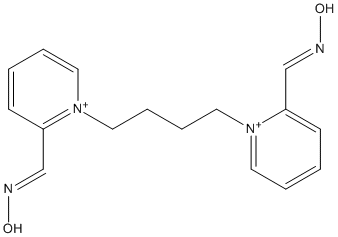K033
General
Type : Bispyridinium, Bisoxime, Oxime
Chemical_Nomenclature : oxo-[[1-[4-[2-(oxoazaniumylmethylidene)pyridin-1-yl]butyl]pyridin-2-ylidene]methyl]azanium
Canonical SMILES : C1=CC(=C[NH+]=O)N(C=C1)CCCCN2C=CC=CC2=C[NH+]=O
InChI : InChI=1S\/C16H18N4O2\/c21-17-13-15-7-1-3-9-19(15)11-5-6-12-20-10-4-2-8-16(20)14-18-22\/h1-4,7-10,13-14H,5-6,11-12H2\/p+2
InChIKey : XBWPUBVQNBIHRE-UHFFFAOYSA-P
Other name(s) : 1,4-bis(2-hydroxyiminomethylpyridinium) butane dibromide, CHEMBL1197954, K-33, AC1O9XJ0, ZINC4480554, K-033, Oxo-[[1-[4-[2-(oxoazaniumylmethylidene)pyridin-1-yl]butyl]pyridin-2-ylidene]methyl]azanium
MW : 300.35
Formula : C16H20N4O2
CAS_number :
CID PubChem :
InChIKey UniChem :
Iuphar :
Wikipedia :

Target
Structure : No structure
Families : No family
References
No reference